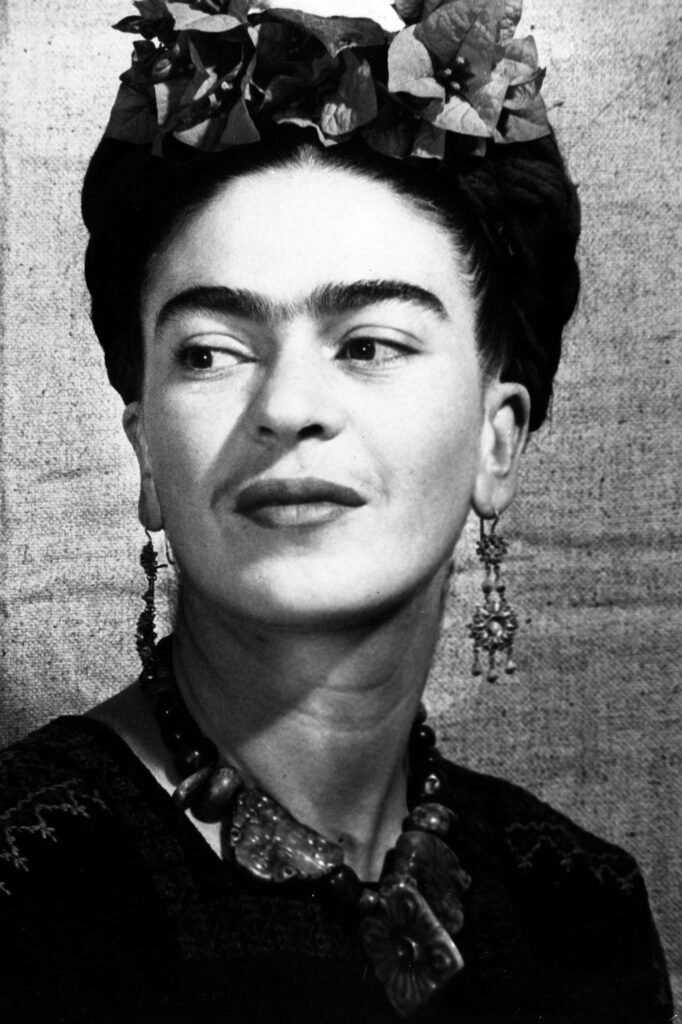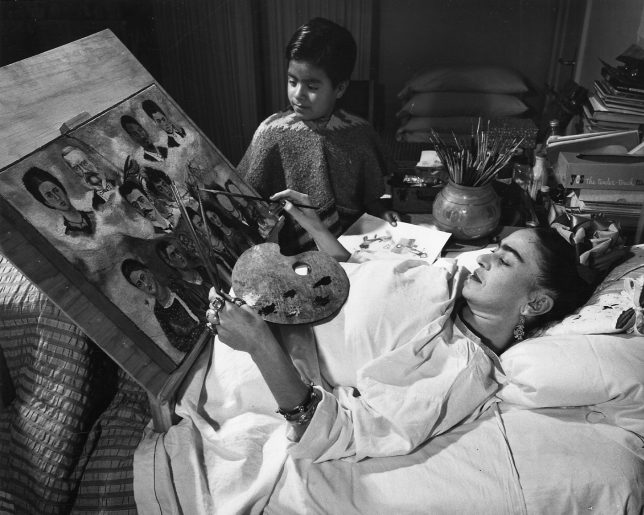Frida Kahlo, the indomitable spirit of Mexican art, was no stranger to the turbulent dance of life. Beyond the iconic unibrow and vibrant attire, Kahlo was a storyteller, a painter who bared her soul on canvases that would later resonate across time. In the kaleidoscope of her creations, one particular masterpiece stands out – Henry Ford Hospital, painted in 1932. This piece is more than oil on Masonite; it’s a visceral expression of pain, love, and the complex dance between life and loss.
Who was Frida Kahlo?

To understand Kahlo’s art, we need a glimpse into the woman behind the brush strokes. Born on July 6, 1907, in Coyoacán, Mexico, Frida’s life was a canvas painted with strokes of both joy and pain. A near-fatal bus accident in 1925 became a turning point, leading her to discover the therapeutic power of art during her prolonged recovery. Her work became an intimate exploration of identity, pain, and the intricate tapestry of human experience.
Her Career: A Palette of Emotions

Frida’s artistic journey was a tumultuous ride through the landscapes of her soul. Inspired by Mexican folk art and deeply rooted in her indigenous heritage, Kahlo’s paintings weren’t just visually striking – they were emotional narratives. Her marriage to Diego Rivera, a giant in the world of Mexican muralism, added another layer of complexity to her story, infusing her art with the vibrant hues of love and turbulence.
Henry Ford Hospital: The Genesis of a Masterpiece
In 1932, Frida Kahlo found herself in Detroit, and fate dealt her a heartbreaking blow – a miscarriage. The pain, both physical and emotional, seared through her, leaving an indelible mark. It was during this period that Henry Ford Hospital came to life on a small Masonite canvas.
What is happening in Henry Ford Hospital

| Artist | Frida Kahlo |
| Date Painted | 1932 |
| Medium | Oil on Masonite |
| Genre | Surrealism |
| Period | 20th Century |
| Dimensions | 12 x 15 inches (30 x 38 cm) |
| Series/Versions | Not part of a series |
| Where is it housed? | Dolores Olmedo Museum, Mexico City |
Henry Ford Hospital isn’t just paint on a board; it’s a glimpse into Frida’s soul at a moment of profound vulnerability. Its enduring legacy lies in its ability to transcend time and space, inviting viewers into the emotional labyrinth of Kahlo’s life.
1. Symbolism Woven into Every Stroke
The canvas portrays Frida, connected by an umbilical cord to a tiny fetus, a potent symbol of her profound loss.
A monkey, a recurring motif in her work, represents protective maternal instincts, underscoring the absence of the child she never held.
2. Medical Imagery as Emotional Landscape
Medical elements, including a pelvic bone and a snail, intertwine with the deeply personal narrative, expressing the slow passage of time during her recovery.
A surgical tool, placed with clinical precision, speaks to the harsh reality of her physical ordeal.
3. The Barren Landscape
The backdrop of the painting, resembling a desolate desert, mirrors the emotional void left by the miscarriage.
A Timeless Reminder
In a world that often celebrates perfection, Kahlo’s portrayal of pain challenges us to embrace vulnerability. Henry Ford Hospital isn’t just a historical artifact; it’s a mirror reflecting our own struggles and resilience.
Influence on Modern Art
Frida Kahlo’s influence extends far beyond her lifetime. Contemporary artists continue to draw inspiration from her unique blend of surrealism and raw emotion. The personal narratives woven into her art resonate with a generation grappling with identity, trauma, and self-discovery.
The Human Touch: Why Henry Ford Hospital Speaks to Us
Frida Kahlo’s ability to infuse human experiences into her art is what makes Henry Ford Hospital unique. It’s not merely a painting but a conversation starter about life’s complexities. Its emotional depth and symbolism create an intimate connection between the artist and the observer.
Connection to Everyday Struggles
Through the lens of Henry Ford Hospital, we find solace in knowing that our struggles are part of the universal human experience. Frida’s art becomes a beacon, guiding us through the ebbs and flows of our own lives.
The Healing Power of Art
For Kahlo, painting was a cathartic process, a means of navigating the stormy seas of her emotions. Henry Ford Hospital stands as a testament to the healing power of art, inviting us to explore our own avenues of self-expression.
Frequently Asked Questions
What are the objects in the Henry Ford Hospital painting?
A male fetus, a snail, a pelvic bone, an orchid Diego gave Kahlo, a machine, and an orthopaedic cast are the six objects connected by a string that represents the umbilical cord.
What are the symbols in the Henry Ford Hospital painting?
Her mental and physical anguish as she attempts to digest the tragedy are depicted in the picture. Kahlo also used motifs in this piece that allude to loneliness and terror, like the twisted figure and the tips of the blankets against the backdrop of a petrified scene.
Conclusion
In the world of art, Henry Ford Hospital isn’t just a painting; it’s a conversation starter, a confessional booth, and a timeless testament to the human spirit. Frida Kahlo’s ability to translate pain into art gives us permission to embrace our own imperfections, creating a space for healing and self-discovery.
As we stand before Henry Ford Hospital, we aren’t just viewers; we are participants in a shared narrative of joy, pain, and the uncharted territories of the human soul. And that, perhaps, is the enduring magic of Frida Kahlo’s art.













